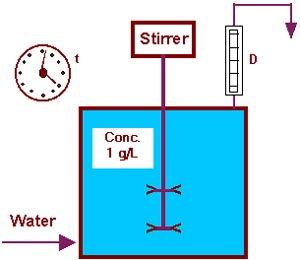
 |
| Introduction of time |
|
To simplify the question, time was eliminated from the "nut to crack"
and the overflow was collected in an equal-sized vessel. In practice a dilution rate (D) and a dilution time (t) are used. D is defined as flow rate (L/h), divided by volume (L), but vessels/h will serve here in the same way. A dilution rate of D = 1 together with a dilution time t = 1 h will give the same result as a filling of an equal-sized vessel: |

|
|
The usual formula for the "nut to crack" reads as follows:
c = c0 * e-Dt = 1 * e- (1 * 1) = 0.368. The same result will be reached with a dilution rate of D = 2 vessels/h together with a dilution time t = 0.5 h: c = 1 * e- (2 * 0.5) = 0.368. Now it is possible to calculate c, D or t for any other combination: e.g. c0 = 40 g/L, D = 3 and t = 1.5 h: c = c0 * e-Dt = 40 * e-(3 * 1.5) = 0.444 g/L. e.g. c = 20 g/L, c0 = 40 g/L, D = 3 20 = 40 / e3 * t t = ln2 / 3 t = 0,231 h |
 |
 |